The alacrity with which Paris went from being utterly inhospitable for cycling into a place where it has become widespread should light a fire of urgency under Hamilton, a city with much less to lose from letting go of the status quo.
By Ryan McGreal
Published September 25, 2015
This article has been updated.
When last I visited Paris, France in early 2011, I was really impressed with how much the city had done to encourage cycling over the previous decade. I've just returned from another visit to Paris, and I'm delighted to report that the city continues to make inspiring progress at building out its cycling network.
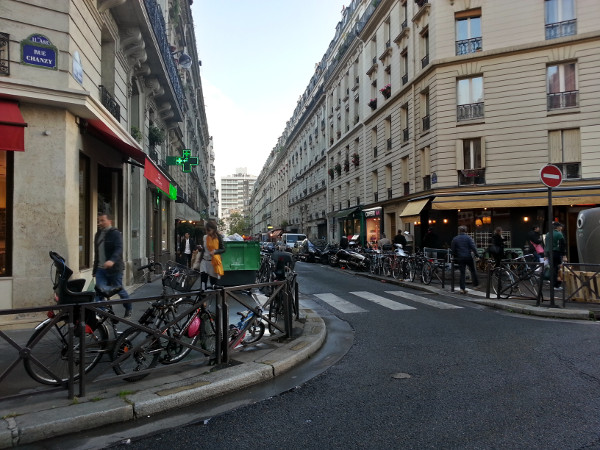
Bicycles parked at Rue Paul Bert and Rue Chanzy
There are more cyclists on the road than ever, and anecdotally I observed a refreshing diversity among the people riding bikes: young and old, male and female, dolled up and dressed down.
Before Paris decided in the late 1990s to become a bicycle-friendly city, cycling was a white-knuckle activity undertaken only by a tiny, fearless sliver of the population. Paris drivers are notoriously aggressive and erratic, and the city's comprehensive transit system and walkable streets were previously considered to be good enough for people not in cars.
But after the one-two punch of a debilitating Metro strike in 1995 and a new public health report demonstrating high levels of premature death from air pollution, the City decided in short order to get serious about providing more transportation alternatives.
Between 2002 and 2008, the cycling percentage of total trips (called the mode share) tripled from just 1 percent to 3 percent and has almost doubled again since then. The fact that cycling has increased so enormously in such a short time in a city with heroically bad traffic and highly constrained lane capacity is a testament to the effectiveness of good cycling infrastructure.
A recent article in Le Figaro notes that there are 225,000 daily bike trips in Paris. Anecdotally, I can say that I saw people riding bikes everywhere I went at all times of the day.
The city is actually accelerating its efforts to build out its cycling network. Currently, Paris has around 700 km of bike lanes, and earlier this year the City announced a plan to double that to 1,400 km by 2020 and increase the bicycle mode share to 15 percent.
Based on consultations with 7,000 residents, the planners have determined that a feeling of insecurity ("un sentiment d'insécurité") keeps many would-be cyclists from choosing to ride a bike, so the emphasis is on an axial network of physically protected cycle tracks running east-to-west and north-to-south across the city.
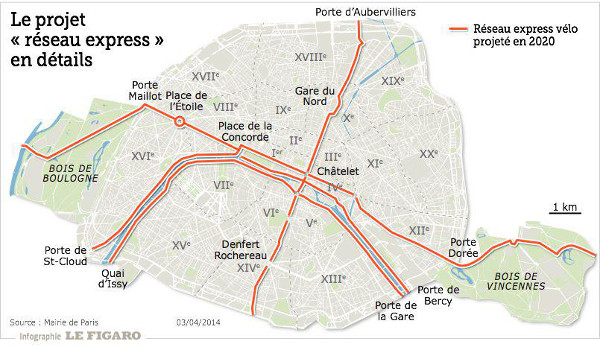
Map of planned axial protected cycle tracks in Paris (Image Credit: Le Figaro)
That includes continuous, protected arterial bike routes along both banks of the Seine - routes that currently serve as very high-volume automobile corridors.
But as Paris embarks on the next wave of infrastructure building, it is worth reviewing what they have already built.
The best cycling infrastructure is physically protected from automobile traffic, and Paris has employed several models of physical protection based on the existing street context. On some streets, the cycle track is protected by a raised curb. In others, it is protected by parallel parked cars.

Curb-protected two-way cycle track

Parking-protected two-way cycle track
There were also a number of off-street cycle tracks, either running at the same grade as the sidewalk on a raised curb, on a path farther away from the street or on an otherwise pedestrian-only street.

Raised-curb bike lane on Quai Banly near Eiffel Tower

Off-street two-way cycle track past Vélib' station
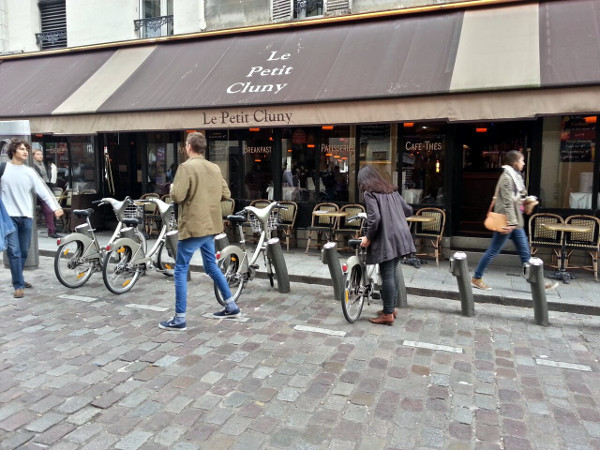
Woman locking a Vélib' rental bike on a pedestrian street in the Latin Quarter

Cycling in pedestrian plaza behind Centre Pompidou
As I mentioned, there are cyclists everywhere in Paris these days.
Paris is renowned for its baroque Metro subway system, but it also operates an extensive network of express bus routes on dedicated transit lanes. Indeed, every boulevard I saw had dedicated transit lanes. Interestingly, a common pattern I observed was for the street to have one lane in each direction for automobile traffic, a raised median, and then one lane in each direction for transit.
But the kicker for cycling is that the transit lanes can also be used as bike lanes, as clearly marked with green-painted bicycle markings (and, of course, lots of use by actual cyclists):

Curb-protected two-way transit lane with cycling

Cycling on two-way transit lane
Even on streets where the transit lane is not physically protected from the adjacent vehicle lanes, cyclists are still allowed to ride - and the extra-wide transit lanes mean they are at a physical remove from automobile traffic.

Cyclist riding on unprotected transit lane

Cyclist riding in transit lane, bundled up on a cold day
It was impressive to see the wide variety of uses for bicycles, including these two cheery bicycle cargo transporters, who grinned at me after I took their photo and gave a thumbs-up.

Bicycle cargo carriers riding in transit lane
After Hamilton's recent facepalming experiment with a transit lane, in which staff were adamant that it should not be allowed to include cyclists during the trial and then Council voted to kill it (against public will and the evidence) instead of making the obvious changes that would have improved how it functions, it's clear we have a lot to learn from cities that already get it right.
One of the big challenges when creating dedicated space for cycling is how to manage intersections. By definition, an intersection is a "conflict zone" where people moving in several different directions come into contact and must navigate past each other.
In Hamilton, we tend to let our bike lanes peter out as they approach intersections: the solid white line turns into a dashed line (for right-turning vehicles) and disappears completely through the intersection itself.
The Cannon Cycle Track improves on the status quo with advanced stop lines, or "bike boxes", which allow cyclists to pull ahead of motorists when making a turn, and with painted markings through intersections to remind turning drivers that they are crossing a bike route.
But the state of the art for intersection design goes to the Netherlands, which has iterated its way to an elegant design that fits into a standard intersection and minimizes the potential for a vehicle to crash into a bike.

Netherlands intersection design (Image Credit: screen-capture from YouTube video)
In effect, the Dutch model transforms a normal junction intersection into a roundabout for cyclists. A number of carefully-calibrated design elements maximize visibility between cyclists, drivers and pedestrians and minimize the potential for conflict.
In Paris, where the streets do not run in a grid and intersections are hairy at the best of times, I saw a similar reasoning at play in how protected cycle tracks navigated through them. (Even on foot, it often feels like you're circling a pedestrian roundabout when crossing through complex intersections.)

Raised curbs, clear markings for bike lanes through an intersection
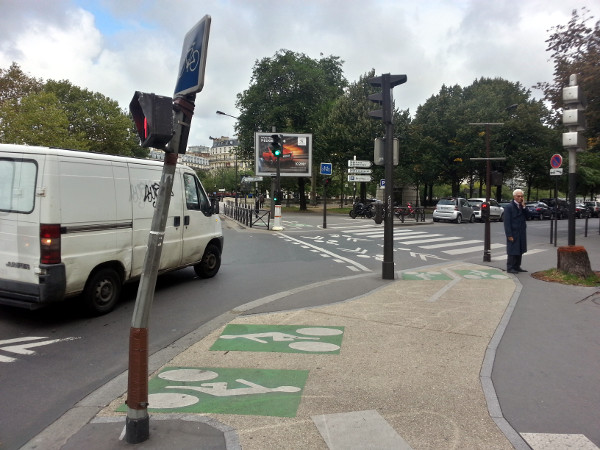
Bike lanes continue through complex intersection

Pavement markings for off-street cycle track next to crosswalk markings
Most of the intersections I saw had the white bike stencil with a green background, but some didn't include the white background:
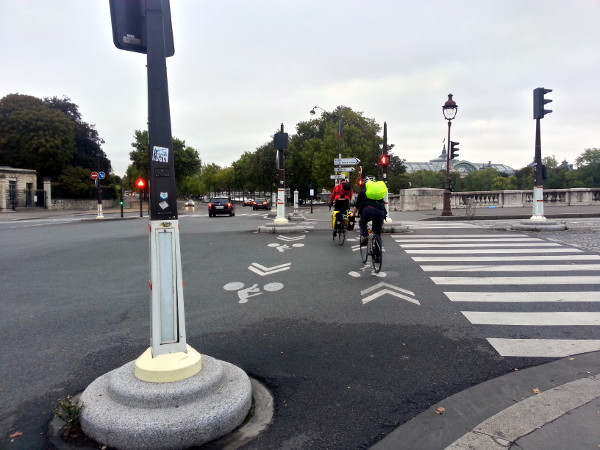
White painted bike lane stencils across intersection
The bike lane intersection designs I saw in Paris were not as sophisticated as the Netherlands model, but I watched them in action and they provided clear elements of visibility and predictability for all road users.
Of course, not every bike lane in Paris is physically protected. Like many cities making the transition toward being more bicycle-friendly, Paris started with relatively low-value bike lanes before recognizing that higher-quality bike lanes are better at attracting new riders.

Painted lanes on Pont d'Austerlitz, a very high-traffic bridge

Overlooking painted bike lanes on Rue Monge
Many Paris streets, especially in the older Left Bank, date back to Medieval times and are very narrow, one-way lanes. There is simply no right-of-way for two-way automobile traffic, let alone physically separated bike lanes. Wherever possible, these streets also shoehorn curbside parking, further eating into the available space.
The City's solution in this context has been to add speed bumps to slow automobile traffic and to paint contraflow bike lanes so that cyclists can ride in either direction.
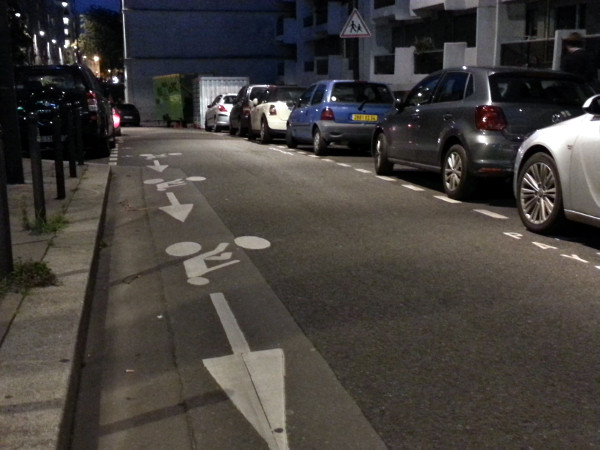
Left-side contraflow bike lane with cars parked on right side
On some streets, the cars are parallel parked on the left side of the street, not the right. In these cases, the contraflow bike lane is painted just outside the paralled parked cars.
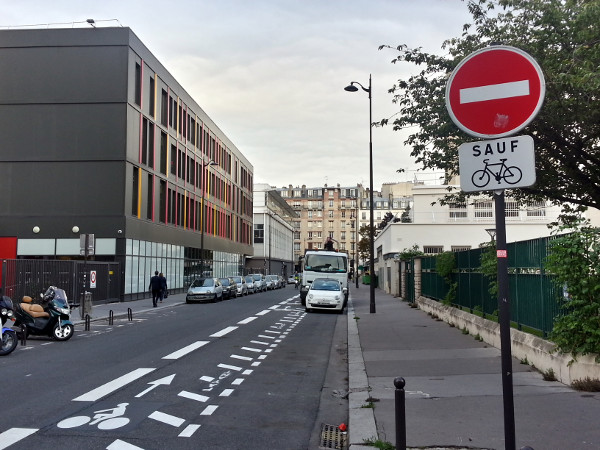
Contraflow bike lane with cars parked on the left side

Contraflow bike lane on narrow street
My first thought on seeing these was shock that the bike lanes are right in the "door zone" of the parked cars. However, the situation is quite a bit better than, say, the door-zone bike lanes on Dundurn Street South in Hamilton:

Contraflow bike lane on Rue Pascal
I can think of at least one narrow, one-way Hamilton street with a contraflow bike lane: Markland Street between James Street South and Queen Street South. Markland is one-way westbound with curbside parking on the north side and an eastbound contraflow bike lane on the south side.
Recent changes to the Highway Traffic Act under Bill 31, the Making Ontario's Roads Safer Act, make it easier for municipalities to add contraflow bike lanes on one-way streets.
We should be looking to take advantage of this and add contraflow bike lanes on every one-way street that is low-volume for automobile traffic and would make a good bi-directional bike route.
A no-brainer is Hunter Street between Queen Street South and Locke Street South. The (frustratingly unprotected) two-way bike lane on Hunter ends at Queen, and Hunter continues as a narrow one-way street westbound from Queen to Locke.

Looking east on Hunter Street west of Queen
As it is, it is only possible to proceed west on Hunter - and in mixed vehicle traffic at that. Short of just making this section two-way, a contraflow bike lane coupled with traffic calming measures - permeable bumpouts, signage and so on - would make Hunter more usable for cyclists, safer for all road users and calmer for people living on the street.
Hess Street also comes to mind as an obvious choice. At York Boulevard, the one-way northbound Hess is so overbuilt that the City literally painted out an entire lane with diagonal hash marks.

Hashed-out lane on Hess Street between York and Cannon (RTH file photo)
Talk about a painless opportunity to add southbound cycling infrastructure!
I leave it as an exercise for the reader to identify other prospective sites for contraflow bike lanes.
The City of Paris clearly treats cycling as a first-class transportation mode. For example, when a section of street is closed for road work and the closure affects a bike lane, the City makes sure to include a detour for cyclists:

Cycle track gets a detour
Paris takes cycling seriously - the goal is to make it so easy, convenient and safe to ride a bike that it becomes a viable choice for a significant share of trips. And this is in a city that already has an excellent transit system and is highly walkable, with many locations clustered in close proximity.
A number of other policy measures also support cycling in Paris. The City recently adopted a city-wide 30 km/h speed limit, supported by traffic calming measures to make it psychologically uncomfortable to drive at dangerous speeds.
Paris has also recognized that bicycles and cars are different things and that it does not make sense for them to be regulated by the same rules. Cyclists are now allowed to treat red lights as yield signals for right turns and at T-junctions.
I can't write about cycling in Paris without giving a nod to the city's famous bike share system. Vélib' - a portmanteau of vélo (bicycle) and libre (freedom) - is a nework of around 20,000 bicycles and 1,200 stations across the city. The system is operated by JCDecaux, an advertising company, in exchange for revenue from on-street billboards and ad signs.

Vélib' station with kiosk
Subscriptions cost €1.70 ($2.50 Cdn) per day, €8 ($12 Cdn) per week or €29 ($43 Cdn) per year, and a subscription covers up to 30 minutes of continuous cycling per trip for an unlimited number of daily trips. After 30 minutes of riding, the cost increases exponentially in order to incentivize people to return bikes into circulation.
This pricing model is slightly different from Hamilton Bike Share's pricing model, in which a subscription covers up to a cumulative total of 60 minutes of riding per day, with additional charges beyond an hour pro-rated to the minute.
As Nicholas Kevlahan noted earlier this summer, Vélib' has a truly impressive market share, with 274,000 annual subscribers and around 110,000 trips per day on average. Certainly a huge proportion of the people I saw cycling were riding on Vélib' bikes.
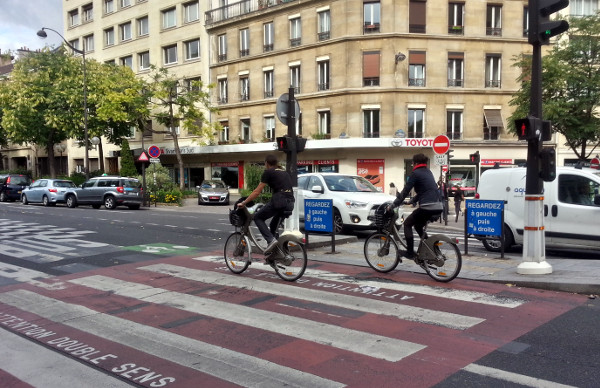
Couple riding Vélib' bikes in transit lane
Paris is a dense, compact city and you don't have to walk far before encountering a station. This makes the system flexible and easy to use. And in a city where most people live in apartment buildings with small (or no) elevators, using a bike share can be a lot more convenient than using your own bike.
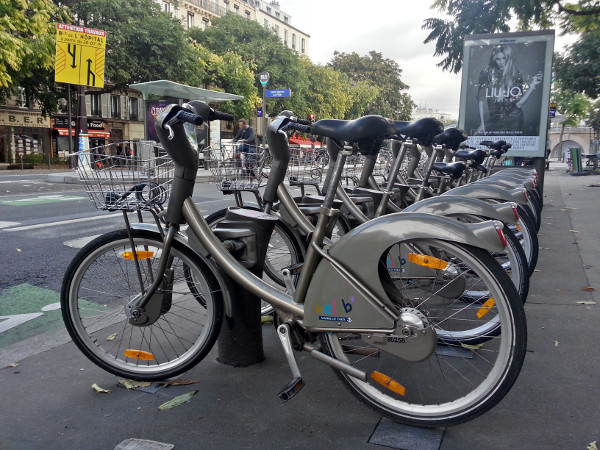
Vélib' station with advertisement in background

Huge Vélib' station near Boulevard de la Bastille

Vélib' station on Île de la Cité
One of the biggest changes in Hamilton since the last time I went to Paris is that we have a bike share of our own. Hamilton Bike Share is only six months old but has already proven that bike share can provide the same convenience, flexibility, affordability and comfort in a young, mid-sized city as it does in a larger, older city like Paris.
On a closing note, I have to address the inevitable cries from the naysayers of "But this is Hamilton, not Paris!" There is no excuse for Hamilton to sit back and accept middling goals and mediocre implementations. In fact, it is harder for a very large, very old city like Paris to change than for a much smaller, younger city like Hamilton.
Every single change in Paris must force itself against the inertia of a huge population and a huge municipal bureaucracy, a physical built environment that literally spans back a thousand years, and a profound sense of reverence for the city's priceless cultural and architectural heritage.
Yet Paris refuses to be a museum piece, locked into past ways of doing things. The city is a living, breathing, evolving dynamic entity that continues to reinvent itself in response to new information and changing values. This is the same city, after all, in which the I.M. Pei Pyramid in the Louvre courtyard was a surface parking lot for government employees as recently as the 1980s!

Louvre Courtyard (RTH file photo)
The alacrity with which Paris went from being utterly inhospitable for cycling into a place where cycling has become widespread and normal should light a fire of urgency under Hamilton, a smaller, younger city with so very much less to lose from letting go of the status quo.
To borrow an inspiring line from RTH contributor Kevin Love: Paris changed. We can too.
Update: this article originally stated that a street only had transit lanes on it, but an alert reader who lives in that area of Paris wrote in to point out that it is actually a boulevard that also has vehicle lanes on the other side of the centre median. RTH regrets the error. You can jump to the photo.
By Pxtl (registered) - website | Posted September 25, 2015 at 13:01:28
Those contra-flow bike-lanes with left-side "wrong-way" parking are very interesting and would be a wonderful idea for some of the more cramped 1-ways downtown. How do they handle intersections for those?
By Pxtl (registered) - website | Posted September 25, 2015 at 13:51:26 in reply to Comment 113982
You're right, I'm just overthinking it. The only weird part is actually that cars are parking in the "oncoming traffic" of the bike-side, and parking cars don't really interact with intersections. At most just pull the bike-lane over to the curb at the intersection and close-off the parking lane, which they'd do anyway in order to get a separate left-turn lane for drivers.
Comment edited by Pxtl on 2015-09-25 13:52:36
By JasonL (registered) | Posted September 25, 2015 at 13:57:14
Wow....fantastic piece.
Again, highlights what the real problem is here: vision. Not snow, rain, hills, traffic, old 'narrow' streets etc.....
So nice to see a city that size be bold and continue to desire to be a world leader, even with the pushback they surely receive on these issues.
By kevlahan (registered) | Posted September 25, 2015 at 14:54:38
Excellent article!
As Ryan points out, the impressive thing is how quickly Paris has gone from a cycle-unfriendly city where cycling was a marginal choice, to a cycle-friendly city where riding a bike is a natural choice for all sorts of people on all sorts of trips.
As someone who lived in Paris in 1994-1998, 2000 and 2011-2012 I can back up Ryan's summary of recent cycling history in the city. For example, during the long 1995 transit strike all the bike shops quickly sold out as people scrambled for alternative ways to get to work, but once the strike was over the bikes disappeared again.
Another point is that Paris is innovating in many directions at the same time and making regular changes and tweaks:
30 km/h standard
more car-free zones and car-free days in more neighbourhoods
the auto lib' electric car sharing system (in 2011)
a massive expansion of LRT in the suburbs
moving to single zone transit pricing for all of greater Paris (10 million people)
more and more bus lanes
P'tit vel lib' bike rentals for children in parks http://blog.velib.paris.fr/ptit-velib/
completely rebuilding the Les Halles transit interchange and underground shopping mall
experiments in citizen engagement like participatory budgetting
getting rid of some of the voie sur berge highways along the Seine http://lesberges.paris.fr
20% geared to income housing (responding to a national law)
etc.
And all this in a huge, old very busy and dense city with a powerful entrenched bureaucracy.
Comment edited by kevlahan on 2015-09-25 14:56:21
By JasonL (registered) | Posted September 25, 2015 at 15:12:15
I keep coming back to this piece just to browse the pics! haha
By kevlahan (registered) | Posted September 25, 2015 at 16:43:42 in reply to Comment 113989
Ryan,
Apparently, starting in September you should be able to get to the airport for a single fare. The 5 zones in Ile de France will be unified in one zone:
http://www.metronews.fr/paris/ratp-passe-navigo-unique-zone-1-2-3-4-5-les-nouveaux-tarifs-passes-au-crible/mogC!jFooaoIn3HrM/
However, I believe the single fare only applies to Navigo (like Presto) weekly (21.25 euros) monthly (70 euros) or annual (770 euros) pass users. I'm not sure whether they are changing the price of single tickets. The goal is increasing fairness and mobility to commuters and residents of Ile de France (especially the poorer residents who tend to commute the greatest distances).
Navigo is available to residents (for free) or visitors (for 5 euros) so it is worth getting one.
The berge project is incremental. I'm not sure whether there is a plan to eventually convert all of them. Lyon did something similar.
Comment edited by kevlahan on 2015-09-25 16:53:47
By kevlahan (registered) | Posted September 25, 2015 at 18:32:52 in reply to Comment 113991
For now it seems only the riverside highways on the right bank (Louvre side) are being renovated. There are some pretty nice pictures of the plans here:
By KevinLove (registered) | Posted September 25, 2015 at 20:00:13
Once again, a vivid demonstration that it is all about infrastructure. Infrastructure that makes walking, cycling or public transit the fastest, easiest and most convenient way of safely travelling from A to B.
Irrelevant are factors such as culture, education, and all forms of "what works everywhere else in the world will not work in our city because..."
By ergopepsi (registered) | Posted September 26, 2015 at 04:23:59
I noticed one thing in all of the pics - no helmets. Parisians seem to make cycling look good (of course!) and relaxing (of course!). I am not a helmet wearer although I do require it of my kids and yes daddy is a hypocrite... But I do like to just hop on my bike in whatever duds I've got on and meander to wherever I have to go. No spandex, no special shoes and no helmet.
Anyway I had to research a bit to see what this no helmet thing was about and came across this article by another gentleman who visited Paris - very interesting. http://www.seattletimes.com/seattle-news...
Helmets are actually not required for anyone over the age of 18 in Ontario. I did not know that either until I looked it up. Now I can tell my kids I'm just obeying the law!
Comment edited by ergopepsi on 2015-09-26 04:31:20
By Haveacow (registered) | Posted September 26, 2015 at 10:54:42
Don't get me wrong I am not being anti cycling here but, Paris HAS TO do this type of planning because they have no other choice. Like Toronto they are in the midst of huge and impressive Rapid Transit building program but, also like Toronto, they really need to spend about 2-3 times what they are actually spending to really make the difference they need to make. So limiting cars and vastly improving cycling is a must because they can't afford to do it any other way. Toronto too is now also building up a large network segregated bicycle lanes and facilities (although at much more conservative pace than Paris) because its simply cheaper than most of the alternatives! Regardless of what the Rob Ford's of the world want more cycling infrastructure is going to be "interfering" with the car travelers of the world. I just whish people would realize that, most Parisians don't care about the mode as long as they get some kind of improvement to their daily transport journeys. Most people in the area around Paris don't live in the old historic city that is pictured in the main map of this article (mainly inhabited by tourists, the rich elite classes and the top portion of the upper middle class). Most of them live in suburbs that good or bad, don't look all that much different than our suburbs. They face daily traffic and transport headaches that would dwarf anything that we put up with. Many of suburban Paris's 14-15 Million commuters take very long bus rides to expensive long distance RER and Regional Commuter Rail Trains to get to their jobs or drive the many expressways in the area as well as the large wide suburban roads. Yes some cycle but just like our suburbs, they don't have much in terms of the new cycling network pictured in this article, yet! The article is correct, Paris's officials are at the least, really trying hard to improve things everywhere. However, its not out of a grand desire to improve all of their countrymen's lot in life. Its because they have no other choice. They live in area that is massive in size and scope (A population of 20 million + in Greater Paris) with not enough resources to fix everything at once.
By JasonL (registered) | Posted September 26, 2015 at 14:02:22 in reply to Comment 113996
This is a good comment, especially with the comparison to TO. Not sure how accurate this is, but TO police said yesterday that they respond to 60,000 bike/car collisions each year. They're long past the point of needing to do something.
This makes Hamiltons refusal to get aggressive with transportation options even more bizarre. We've even heard logic from city councillors stating their lack of urgency stems from the fact that we don't have a transportation crisis yet. Someday perhaps we'll elect leaders who see the value in planning ahead, and not waiting until a crisis is on our hands when it costs more and is more difficult.
By John Neary (registered) | Posted September 26, 2015 at 19:05:27 in reply to Comment 113983
By kevlahan (registered) | Posted September 27, 2015 at 09:15:03 in reply to Comment 113996
I'm not sure where the "14-15 million commuters" comes from! The entire population of Ile de France is only 12 million (not 20 million as you claim) and that of course includes children, seniors and all those people who don't commute to central Paris. Please don't just make things up to try to make a point.
As I stated in a previous comment, there is now a uniform price for weekly, monthly an annual passes throughout Ile de France. At just 70 euros, it is hardly "expensive" (about the same as a monthly HSR pass at $94.60 for a far smaller and worse system).
I spent Sept 2011 to June 2012 commuting from central Paris to Lozère station, almost at the southern end of zone 4 on line B, so I have a pretty good idea of what commuters face.
Cities always have a choice: they can choose to do nothing as the GTA did for about 30-40 years which is why the Liberals eventually launched the Big Move to try to catch up. If the Conservatives had won, they would have cancelled the projects. There is nothing inevitable about this.
And, similarly, Paris did nothing about bike infrastructure until recently and they decided (not because they had no other choice) but as a deliberate strategic decision by a Bertrand Delanoe (socialist Mayor for 13 years from 2001 to 2014) to favour pedestrians and cyclists and de-emphasize motor vehicles. This policy has been followed by fellow socialist Anne Hidalgo who succeeded him, and had been deputy Mayor. If the right wing had remained in power we would not have seen these changes, and they are still largely skeptical.
These choices, like the decision to move to a uniform rate of 70 euros for a transit pass, were very much taken 'to improve their countrymen's lot in life'. There is no reason at all that couldn't have kept on without bike lanes, or with differential fares based on distance. There is also no reason that had to enforce 20% geared to income apartments in every municipality with more than 50,000 residents. These are all political choices that are controversial, difficult and expensive. It is usually easier and more comfortable for politicians to do nothing.
I'm not sure which suburbs of Paris you've visited, but many suburbs have also greatly increased the number of km of bike lanes and significantly calmed traffic.
Comment edited by kevlahan on 2015-09-27 09:33:48
By kevlahan (registered) | Posted September 27, 2015 at 09:26:25 in reply to Comment 113996
I'm also not sure where you get the idea that only the rich live in central Paris and the suburbs are poor. The picture is a lot more subtle than this stereotype, as you can see from this map of median revenue by
http://www.insee.fr/fr/themes/document.a...
As you can see there are still three large low income arrondissements in Paris, and much of Paris is close to median income (apart from the centre and west). The richest areas are actually the western suburbs and the poorest areas are the inner suburbs just northeast and southeast of Paris.
In fact, the income map of Paris doesn't actually look much different from the map of Ile de France as a whole.
The picture is a lot more complicated than a 'rich Paris poor suburbs' stereotype, and there is still a lot of diversity within Paris.
Comment edited by kevlahan on 2015-09-27 09:34:39
By kevlahan (registered) | Posted September 27, 2015 at 17:15:31 in reply to Comment 114000
Not to belabour the point, but the three "poor" suburbs (lowest of the five median income bins in Ile de France INSEE study) account for 26% of the total population of Paris.
If you add in the 10th and 13th (which are in the middle income bin) then 38% of the population of Paris proper are roughly median income or below based on the entire Ile de France level. This is far from the stereotype of "only rich, upper middle class and tourists".
As the INSEE study emphasizes, the problem is that the there is a big separation between the poorer areas and richer areas that seems to be increasing. But this is true across Ile-de-France as well as in Paris.
Comment edited by kevlahan on 2015-09-27 17:23:15
By Pxtl (registered) - website | Posted September 28, 2015 at 10:43:13 in reply to Comment 113998
Need them on York Boulevard from Bay to Hess to give York a proper ending. And on Hess itself... along with every other minor 1-way road with left-side parking from Dundurn to Mary.
By The real reason for bike infrastructure (anonymous) | Posted September 30, 2015 at 05:47:02
Price of gas in Paris: 1.41 Euro per litre. That's 2.12 in our dollars.
This is from expatistan dot com/price/gas/paris
Price of gas in Hamilton: 99.8 cents per litre. As per CBC Hamilton.
That's why people are dumping their cars and riding bikes.
By Cultosaurus (registered) | Posted September 30, 2015 at 11:33:31 in reply to Comment 114011
That doesn't even enter peoples' decision making process when choosing to use a mode of transportation. I don't think about the price of gas in the US or UAE when I go to fill up. You think in your own country's currency and cost scale. 1.41 Euro is just like us spending $1.41 on a litre, you don't do a comparison and then decide, shit I'm not going to drive today because they get way more for their dollar in Rochester.
By Pxtl (registered) - website | Posted September 30, 2015 at 12:46:39 in reply to Comment 114013
If we had some little indicator where people saw the effective price-per-km on their car? Yes, people might make decisions based on cost. But as long as the price-per-trip is invisible for driving and visible for transit, nobody is going to compare them properly.
By tired (anonymous) | Posted September 30, 2015 at 15:31:04 in reply to Comment 114017
Maybe you are tired of it because of your world view.
For the people who has to own a car - say they commute, own a cottage or have a kid in rep hockey, the fixed costs for that expense warp their mindset. They find it hard to justify spending money on public infrastructure they will never use.
Lame excuses are no justification for poor urban planning, but some people, and my guess it is a very large percentage of the population, public transit is a non-starter.
Reading this site make me think that people are talking at each other rather than listening to each other and so probably everyone is tired.
By JasonL (registered) | Posted September 30, 2015 at 18:11:49 in reply to Comment 114018
They find it hard to justify spending money on public infrastructure they will never use.
More people travelled in our transit lane on King than the other 3 lanes combined. All the public money for public infrastructure comes from everyone.
What you're saying is 'I own a car therefore I'm more important as a human than those people on transit or bikes'.
Certain segments of society should be tired of subsidizing the others though:
By no sense (anonymous) | Posted September 30, 2015 at 18:12:55 in reply to Comment 114013
Dude, you're not making sense. If I were in Paris, and my minimum wage is 8.24 USD (see businessinsider dot com/minimum-wage-around-the-world-2015-5 ) and the price of gas is $1.58 USD, I think I would be making driving decisions based on that. Here, with minimum wage being $11.25 and gas being under a dollar, it's costing me a lot more to drive than bike anywhere. So yeah, I'm going to be asking for bike infrastructure because it's not cheap to drive. Here, 10% of my pay per hour pays for a litre of gas. It's way more cost effective to drive here, and as such, people drive more and cycle less.
By Strawman (anonymous) | Posted September 30, 2015 at 18:14:54 in reply to Comment 114012
By kevlahan (registered) | Posted September 30, 2015 at 19:34:25 in reply to Comment 114021
Cycling in central Paris tripled in the ten years 2004-2014:
http://www.lemonde.fr/economie/article/2...
Velib was introduced in 2007, Delanoe launched his cycle route plan in 2002. The number of kilometres of cycle lanes increased from 256 km in 2001 to 700 km in 2015 also since 2008 29 km of bus lanes are available to cyclists. 729 km is almost triple the distance of cycle lanes in 2001. You'll note that the growth in cycling has tracked the growth in cycle lanes, with an extra bump from velib.
https://en.wikipedia.org/wiki/Cycling_in...
https://www.google.ca/url?sa=t&rct=j...
According to 'Institut d'aménagement et d'urbanisme (IAU) quoted in the Le Monde article
Il y a quinze ans, le vélo était « quasi inexistant » à Paris.
And the huge growth in cycling is completely obvious to anyone has visited Paris regularly over the last 10-20 years.
Those are the facts and they are pretty convincing!
Comment edited by kevlahan on 2015-09-30 19:41:13
By mdrejhon (registered) - website | Posted October 07, 2015 at 02:40:13 in reply to Comment 114021
It also happened to New York City too:
More than 10x as much biking today, when NYC created some protected bike infrastructure.
New York City, of all things!
Next time I am in either Paris or New York City, I'm definitely renting a bike (bikeshare).
Comment edited by mdrejhon on 2015-10-07 02:42:36
By mdrejhon (registered) - website | Posted October 07, 2015 at 02:43:12 in reply to Comment 114020
You must be logged in to comment.
There are no upcoming events right now.
Why not post one?